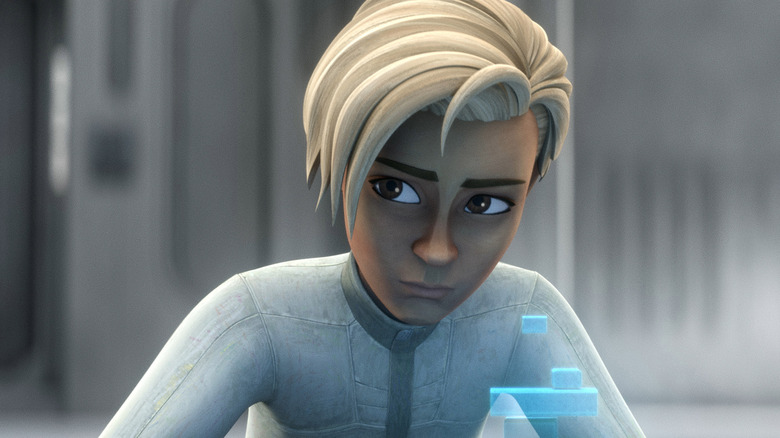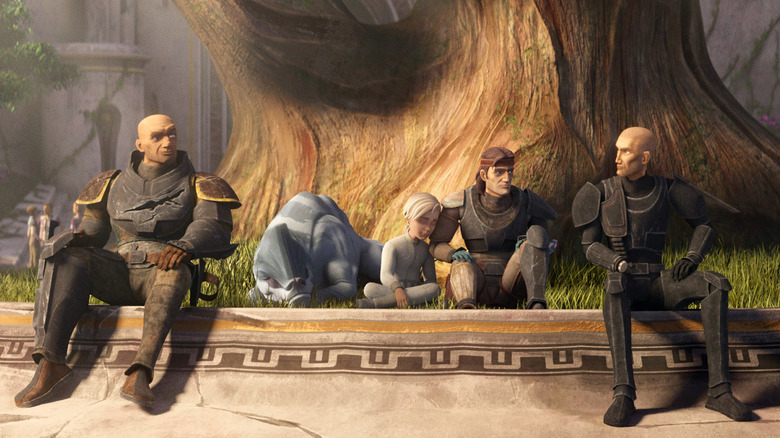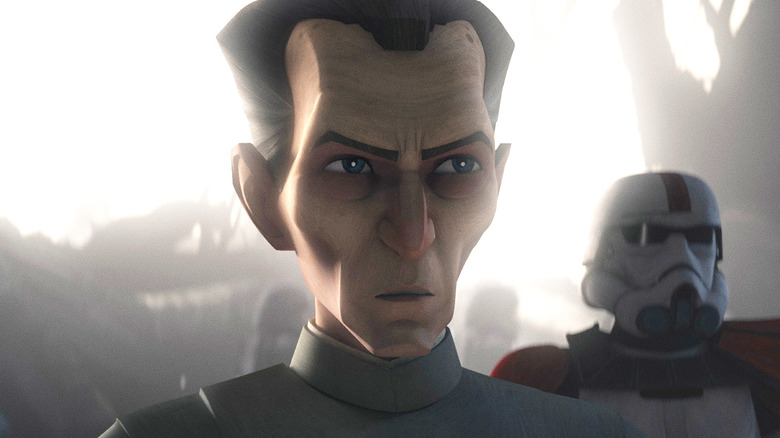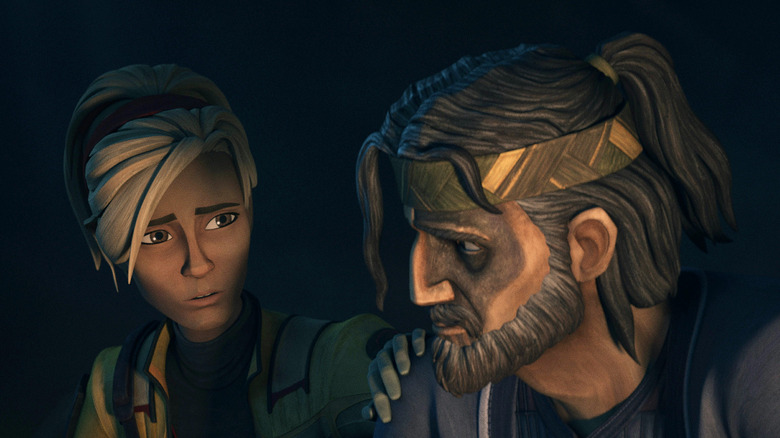The Bad Batch Series Finale Explained: A Star Wars Era Concludes
This article contains spoilers for "Star Wars: The Bad Batch" season 3, episode 15, "The Cavalry Has Arrived."
"The Cavalry Has Arrived" is a fitting title for the end of "Star Wars: The Bad Batch," the animated series that was as much a continuation of "Star Wars: The Clone Wars" as it was its own distinct show. Revolving around the genetically altered Clone Force 99, as first introduced in "The Clone Wars," "The Bad Batch" spent three seasons offering us a window into the plight of clones in the days and years following the creation of the Empire and how these particular clones were able to carve their niche in the galaxy. One of the key motivators for this group of former Republic special forces is Omega. She's a special clone and vital to the Emperor's plans to clone himself should something happen to him. Her blood seems to be the only sample the Empire has found that replicates midi-chlorians, so they need her to be the binding agent, tying the entire show into Palpatine's struggles that thread through "The Mandalorian" and culminate in the events of "The Rise of Skywalker."
Throughout the show, the Bad Batch has learned to be a family rather than a group of soldiers, and every member of the group has spent time playing father to Omega — none more so than Hunter, the leader of the pack. Season 2 ended on a brutal cliffhanger, with Omega caught by the villainous Dr. Hemlock, who takes her to his top-secret hideout on Mount Tantiss. As such, season 3 has been devoted to that final conflict, with everyone struggling for custody of Omega as she's relentlessly pursued (and eventually recaptured) by the Imperials.
Omega to the Bad Batch's rescue
The show's second-to-last episode brought Hunter and the team to the base of the Empire's secret science facility on Mount Tantiss, looking for a way to break in and rescue Omega. For her part, Omega planned her escape from the inside and sowed as much chaos as she could in order to help affect her rescue.
As we guessed last week, the Zillo beast featured prominently in Omega's plan. She was able to unleash the creature and it promptly tore through two of Dr. Hemlock's divisions of Stormtroopers and stormed out of the base, creating a way in for the rest of the Bad Batch to infiltrate the base and initiate their rescue operation. While Echo and Omega are able to free the captured clones and the children that Hemlock had paid bounty hunters like Cad Bane to abduct for his experiments, the rest of the team is wounded and captured. In one particularly brutal scene, Crosshair's shooting hand is even hacked off and Hunter is tortured. There was definitely a moment in that torture where it was easy to think "The Bad Batch" could very much end on a down note. By playing up Wrecker's wounds and Hemlock's superior position, the audience was definitely conditioned to worry that things would go as bad as they possibly could.
Fortunately, Omega, Echo, and the rescued clones become the cavalry themselves, affecting a rescue for the Batch. There's a final confrontation with Dr. Hemlock and a final rescue that brings together everything that makes "The Bad Batch" great: teamwork and the pathos of rescuing family. The idea is that they should believe in each other no matter what and their family matters. Thematically, it's something exemplified by Nala Se's sacrifice in this episode and acts as a microcosm for what eventually happens to the entire Empire, in Rampart's case.
The ramifications of the Bad Batch finale
With the destruction of Nala Se's scientific data on Mount Tantiss, as well as the loss of Dr. Hemlock, Governor Tarkin arrives to cancel this iteration of Project Necromancer. We know that the project will ultimately resume with Dr. Pershing's involvement (as seen on "The Mandalorian," this is how Grogu winds up being targeted), even beyond the life of the Empire. We also know it will result in an imperfect clone of Palpatine as the Sith Eternal in "The Rise of Skywalker," which means this chapter isn't closed completely.
On top of all that, we know Palpatine is still going to win that fight — at least until Rey rejects her lineage and calls upon all of the Jedi to defeat him.
For now, though, the big winner in this particular fight is Tarkin himself and, by extension, Director Krennic. By the end of this episode, Tarkin orders all of the funding and resources that had been drained by Project Necromancer to instead be transferred to Project Stardust. For those who've forgotten, Stardust was the codename given to the Death Star Project by Galen Erso, in honor of his nickname of his daughter, Jyn. All of that happened in "Rogue One: A Star Wars Story," which is hailed by many as the best of the "Star Wars" movies since Disney's purchase of Lucasfilm.
With the additional funding, this means the Death Star will be able to come to fruition and serve as Tarkin's personal station at the end of his life, regardless of how quickly it ends up being destroyed by the Rebellion.
The coda and the future of Star Wars
Like "Star Wars Rebels" before it, "The Bad Batch" ends by leaping ahead in time to give us a coda and an indication of where its story is heading next. In the case of "The Bad Batch," it's a particularly happy, tear-jerker of an ending. The time skip implies that, for at least most of the Empire's dark reign, the Bad Batch earned a quiet retirement on their tropical paradise planet of Pabu. There, they were able to raise Omega, who grew up to be a highly motivated and capable kid. How could she not with a "Three Men and a Baby"-type situation with Hunter, Wrecker, and Crosshair? However, the code also includes a heartbreaking moment where she has to say goodbye to Hunter so she can make her way and fight in the Rebellion against the Empire (all while the Galactic Civil War heats up in ways they couldn't have imagined in those early days resisting the tyranny and oppression of the Imperials).
Giving characters like the soldiers of "The Bad Batch" an easy retirement in the coda is heartwarming, and watching Omega break out on her own elicits tears, but it also promises more stories in the future. Will there be room to tell stories of the Batch getting back into the fight? What battles will Omega take part in? How will she help turn the tide against the Empire?
Like any good ending, "The Bad Batch" offers us a promise of the future. And I hope we get to see it, whether it's in animation or live-action. There are more stories set in the classic trilogy era and the team behind "The Bad Batch" has proven those stories deserve to be told at some point.
In the meantime, all we can do is hope they decide to tell them.
All three seasons of "Star Wars: The Bad Batch" are now streaming on Disney+.



